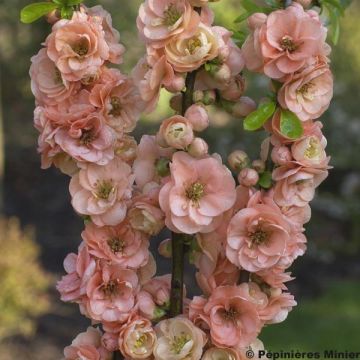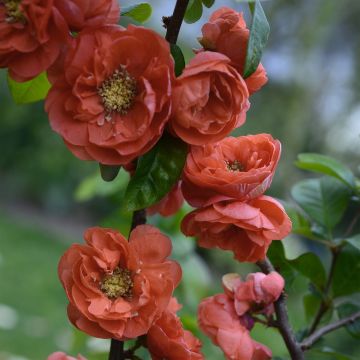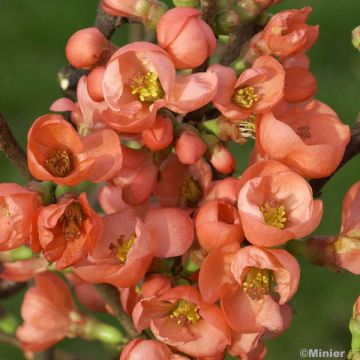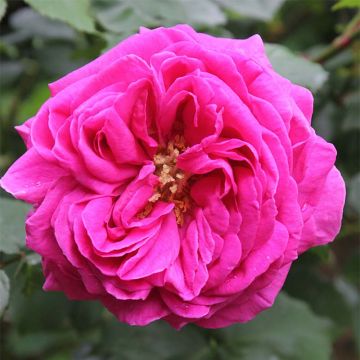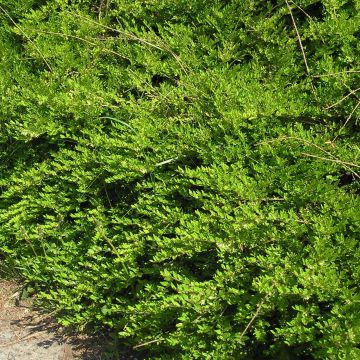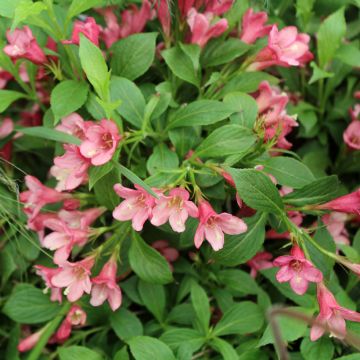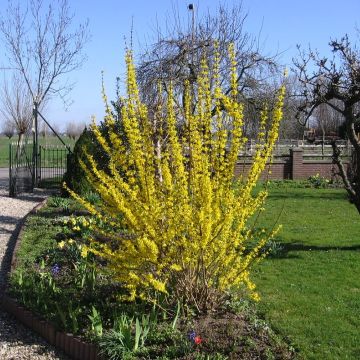

Chaenomeles japonica Orange Beauty - Flowering Quince
Chaenomeles japonica Orange Beauty
Japanese Quince
Why not try an alternative variety in stock?
View all →This plant carries a 24 months recovery warranty
More information
We guarantee the quality of our plants for a full growing cycle, and will replace at our expense any plant that fails to recover under normal climatic and planting conditions.
From €5.90 for pickup delivery and €6.90 for home delivery
Express home delivery from €8.90.
Does this plant fit my garden?
Set up your Plantfit profile →
Description
Chaenomeles japonica 'Orange Beauty' is a beautiful variety of Japanese quince with abundant spring flowering in semi-open, single, orange-vermilion cups. Pear-shaped fruits, which are initially green then yellow, form in autumn and are consumed cooked as jellies or jams. It is a deciduous and vigorous bush forming a shrub wider than it is tall. Its tendency to spread near the ground and its somewhat disordered appearance is especially suitable for defensive hedges or ground cover in gardens with a more natural style. Hardy and undemanding, it only fears heavy, too chalky or too dry soils. Its maintenance is limited to pruning after flowering to rebalance the branches and form the numerous suckers that appear every year.
Chaenomeles japonica belongs to the Rosaceae family, just like apple and pear trees. This shrub is native, as its name suggests, to Japan. Its foliage is deciduous, it grows in spring and falls in autumn. The cultivar 'Orange Beauty' forms an exceptionally vigorous quince tree.
It is a small shrub, with a bushy habit that spreads by producing suckers from its stump and often forms somewhat tangled, irregular, almost thornless branches. It will reach an average height of 1.5m (5ft) and a width of 2m (7ft), depending on growing conditions. Flowering takes place in March-May in average climates. When the winter is mild, it can start as early as March, before the leaves appear. The leaves are entire, ovate to lanceolate, 3 to 6 cm (1 to 2in) long and 1.5 to 3cm (1in) wide, with a beautiful shiny green on their upper surface. The flowers bloom for 4 to 6 weeks, first on bare branches, then among the young leaves. They are wide, 3cm (1in) cups, with 5 petals, and their orange-vermilion colour is intermediate between light red and orange. They are grouped in 3 or 4 small clusters and are carried by a very short or even absent pedicel on the previous year's branches. After pollination by bees and other insects, they give way to round fruits, 6 to 7cm (2 to 3in) in size, which turn yellow from the end of summer. These fruits, sometimes beautifully tinged with orange, are consumed cooked.
This Japanese quince is a rewarding shrub, both easy to grow and decorative at a time when most plants are still dormant. Compact, it finds its place even in small gardens, or in a container on a terrace or balcony. Japanese quinces, like Forsythias, Abeliophyllum, and Japanese kerrias, are among the first to provide beautiful spring flowers, so eagerly awaited after a long winter. They are comfortable in all climates, as they are not afraid of either heat or cold. They can be grown both as stand-alone specimens and in borders, and of course in a country hedge. For example, plant it with Lonicera fragrantissima. To save space, you can also train its branches against a wall, on a wire frame, and accompany it with a winter jasmine. Its still bare but bud-filled branches look beautiful in tall vases.
Report an error about the product description
Chaenomeles japonica Orange Beauty - Flowering Quince in pictures


Plant habit
Flowering
Foliage
Botanical data
Chaenomeles
japonica
Orange Beauty
Rosaceae
Japanese Quince
Cultivar or hybrid
Other Chaenomeles - Quince tree
Planting and care
Chaenomeles japonica 'Orange Beauty' prefers partial shade or full sun. You can grow it in shade, but it will flower a little less. Plant it in moist but well-drained ordinary soil without excess limestone. It will tolerate drought well after 3 years of cultivation. It is an easy plant to grow and is resistant to cold. When planting, mix your soil with compost. When grown as a hedge, space the plants 1m (3ft) apart. In a flower bed, the plants should be spaced 60 to 80cm (24 to 32in) apart. This Japanese quince tree is resistant to pollution. It requires little maintenance, except for occasional pruning of the longest branches in spring, as they sometimes become less flowering.
Planting period
Intended location
Care
This item has not been reviewed yet - be the first to leave a review about it.
Foolproof Shrubs
Haven't found what you were looking for?
Hardiness is the lowest winter temperature a plant can endure without suffering serious damage or even dying. However, hardiness is affected by location (a sheltered area, such as a patio), protection (winter cover) and soil type (hardiness is improved by well-drained soil).

Photo Sharing Terms & Conditions
In order to encourage gardeners to interact and share their experiences, Promesse de fleurs offers various media enabling content to be uploaded onto its Site - in particular via the ‘Photo sharing’ module.
The User agrees to refrain from:
- Posting any content that is illegal, prejudicial, insulting, racist, inciteful to hatred, revisionist, contrary to public decency, that infringes on privacy or on the privacy rights of third parties, in particular the publicity rights of persons and goods, intellectual property rights, or the right to privacy.
- Submitting content on behalf of a third party;
- Impersonate the identity of a third party and/or publish any personal information about a third party;
In general, the User undertakes to refrain from any unethical behaviour.
All Content (in particular text, comments, files, images, photos, videos, creative works, etc.), which may be subject to property or intellectual property rights, image or other private rights, shall remain the property of the User, subject to the limited rights granted by the terms of the licence granted by Promesse de fleurs as stated below. Users are at liberty to publish or not to publish such Content on the Site, notably via the ‘Photo Sharing’ facility, and accept that this Content shall be made public and freely accessible, notably on the Internet.
Users further acknowledge, undertake to have ,and guarantee that they hold all necessary rights and permissions to publish such material on the Site, in particular with regard to the legislation in force pertaining to any privacy, property, intellectual property, image, or contractual rights, or rights of any other nature. By publishing such Content on the Site, Users acknowledge accepting full liability as publishers of the Content within the meaning of the law, and grant Promesse de fleurs, free of charge, an inclusive, worldwide licence for the said Content for the entire duration of its publication, including all reproduction, representation, up/downloading, displaying, performing, transmission, and storage rights.
Users also grant permission for their name to be linked to the Content and accept that this link may not always be made available.
By engaging in posting material, Users consent to their Content becoming automatically accessible on the Internet, in particular on other sites and/or blogs and/or web pages of the Promesse de fleurs site, including in particular social pages and the Promesse de fleurs catalogue.
Users may secure the removal of entrusted content free of charge by issuing a simple request via our contact form.
The flowering period indicated on our website applies to countries and regions located in USDA zone 8 (France, the United Kingdom, Ireland, the Netherlands, etc.)
It will vary according to where you live:
- In zones 9 to 10 (Italy, Spain, Greece, etc.), flowering will occur about 2 to 4 weeks earlier.
- In zones 6 to 7 (Germany, Poland, Slovenia, and lower mountainous regions), flowering will be delayed by 2 to 3 weeks.
- In zone 5 (Central Europe, Scandinavia), blooming will be delayed by 3 to 5 weeks.
In temperate climates, pruning of spring-flowering shrubs (forsythia, spireas, etc.) should be done just after flowering.
Pruning of summer-flowering shrubs (Indian Lilac, Perovskia, etc.) can be done in winter or spring.
In cold regions as well as with frost-sensitive plants, avoid pruning too early when severe frosts may still occur.
The planting period indicated on our website applies to countries and regions located in USDA zone 8 (France, United Kingdom, Ireland, Netherlands).
It will vary according to where you live:
- In Mediterranean zones (Marseille, Madrid, Milan, etc.), autumn and winter are the best planting periods.
- In continental zones (Strasbourg, Munich, Vienna, etc.), delay planting by 2 to 3 weeks in spring and bring it forward by 2 to 4 weeks in autumn.
- In mountainous regions (the Alps, Pyrenees, Carpathians, etc.), it is best to plant in late spring (May-June) or late summer (August-September).
The harvesting period indicated on our website applies to countries and regions in USDA zone 8 (France, England, Ireland, the Netherlands).
In colder areas (Scandinavia, Poland, Austria...) fruit and vegetable harvests are likely to be delayed by 3-4 weeks.
In warmer areas (Italy, Spain, Greece, etc.), harvesting will probably take place earlier, depending on weather conditions.
The sowing periods indicated on our website apply to countries and regions within USDA Zone 8 (France, UK, Ireland, Netherlands).
In colder areas (Scandinavia, Poland, Austria...), delay any outdoor sowing by 3-4 weeks, or sow under glass.
In warmer climes (Italy, Spain, Greece, etc.), bring outdoor sowing forward by a few weeks.

































